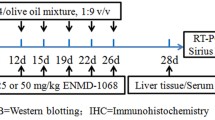Abstract
To investigate the effects of β-elemene on the ANG II-AT1 receptor pathway in rats with liver fibrosis, a model of hepatic fibrosis was induced by hypodermical injection of carbon tetrachloride (CCl4) into Wistar male rats. β-elemene was intraperitonealy administered into the rats for 8 weeks (0.1 mL/100 g body weight per day). Masson staining was used to observe the liver fibrosis of rats and liver functions were measured by enzymatic kinetic analysis. The content of hydroxyproline in liver tissues was detected by specimen alkaline hydrolysis. The level of plasma ANG in blood II plasma was detected by radioimmunoassay. The expression of AT1R in rat liver were measured using reverse transcriptional-polymerase chain reaction and immunohistochemistry respectively. The results showed that β-elemene could reduce the collagen disposition in liver and inhibit the progression of liver fibrosis. In addition, the levels of plasma ANG II and the expression of hepatic AT1R in rats with liver fibrosis were also suppressed by β-elemene. It is concluded that the ANG II-AT1 receptor pathway plays an important role in the development of hepatic fibrosis and β-elemene could down-regulate the levels of plasma ANG II and the expression of hepatic AT1R in rats with liver fibrosis.
Similar content being viewed by others
References
Albanis E, Friedman SL. Hepatic fibrosis. Pathogenesis and principles of therapy. Clin Liver Dis, 2001,5(2): 315–334
Matsusaka T, Ichikawa I. Biological functions of angiotensin and its receptors. Annu Rev Physiol, 1997,59: 395–412
Bataller R, Ginès P, Nicolás JM, et al. Angiotensin II induces contraction and proliferation of human hepatic stellate cells. Gastroenterology. 2000,118(6):1149–1156
Yoshiji H, Kuriyama S, Yoshii J, et al. Angiotensin-II type 1 receptor interaction is a major regulator for liver fibrosis development in rats. Hepatology, 2001,34(4): 745–750
Paizis G, Cooper ME, Schembri JM, et al. Up-regulation of components of the renin-angiotensin system in the bile duct ligated rat liver. Gastroenterology, 2002,123(5): 1667–1676
Powell EE, Edwards-Smith CJ, Hay JL, et al. Host genetic factors influence disease progression in chronic hepatitis C. Hepatology, 2000,31(4): 828–833
Ramalho LN, Ramalho FS, Zucoloto S, et al. Effect of losartan, an angiotensin II antagonist, on secondary biliary cirrhosis. Hepatogastroenterology, 2002,49(48):1499–1502
Paizis G, Gilbert RE, Cooper ME, et al. Effect of angiotensin II type 1 receptor blockade on experimental hepatic fibrogenesis. J Hepatol, 2001,35(3):376–385
Yoshiji H, Yoshii J, Ikenaka Y, et al. Inhibition of renin-angiotensin system attenuates liver enzyme-altered preneoplastic lesions and fibrosis development in rats. J Hepatol, 2002,37(1):22–30
Wei HS, Lu HM, Li DG, et al. The regulatory role of AT1 receptor on activated HSCs in hepatic fibrogenesis: effects of RAS inhibitors on hepatic fibrosis induced by CCl4. World J Gastroenterol, 2000,6(6):824–828
Croquet V, Moal F, Veal N, et al. Hemodynamic and antifibrotic effects of losartan in rats with liver fibrosis and/or portal hypertension. J Hepatol, 2002,37(6):773–780
Liu C, Guo G, Hu ZY. Effect of zedoary rhizome on the renal interstitial fibrosis in rats induced unilateral ureteral obstruction. Shanghai J Tradit Chin Med, 2006,40(12): 71–73
Jamall IS, Finelli VN, Que Hee SS. A simple method to determine nanogram levels of 4-hydroxyproline in biological tissues. Anal Biochem (Chinese), 1981,112(1): 70–75
Oparil S, Haber E. The renin-angiotensin system. N Engl J Med, 1974,291(9):446–457
Bataller R, Gines P, Nicolas JM, et al. Angiotensin II induces contraction and proliferation of human hepatic stellate cells. Gastroenterology, 2000,118(6):1149–1156
Timmermans PB, Wong PC, Chiu AT, et al. Angiotensin II receptors and angiotensin II receptor antagonists. Pharmacol Rev, 1993,45:205–251
Li X, Meng Y, Wu P, et al. Angiotensin II and Aldosterone stimulating NF-kappaB and AP-1 activation in hepatic fibrosis of rat. Regul Pept, 2007,138(1):15–25
Yoshiji H, Kuriyama S, Fukui H. Blockade of renin-angiotensin system in antifibrotic therapy. J Gastroenterol Hepatol, 2007,22(Suppl 1):S93–S95
Yoshiji H, Kuriyama S, Yoshii J, et al. Angiotensin-II type 1 receptor interaction is a major regulator for liver fibrosis development in rats. Hepatology, 2001,34(4): 745–750
Yang L, Bataller R, Dulyx J, et al. Attenuated hepatic inflammation and fibrosis in angiotensin type 1a receptor deficient mice. J Hepatol, 2005,43(2):317–323.
Kanno K, Tazuma S, Chayama K. AT1A-deficient mice show less severe progression of liver fibrosis induced by CCl4. Biochem Biophys Res Commun, 2003,308(1): 177–183
Wei YH, Jun L, Qiang CJ. Effect of losartan, an angiotensin II antagonist, on hepatic fibrosis induced by CCl4 in rats. Dig Dis Sci, 2004,49(10):1589–1594
Shen FJ, Zhu YK, Jia JD, et al. The effect of angiotensin II type 1 receptor blocker valsartan in preventing hepatic fibrosis induced by dimethylnitrosamine in rats. Zhonghua Gan Zang Bing Za Zhi (Chinese), 2004,12(10):605–608
Ueki M, Koda M, Yamamoto S, et al. Preventive and therapeutic effects of angiotensin II type 1 receptor blocker on hepatic fibrosis induced by bile duct ligation in rats. J Gastroenterol, 2006,41(10):996–1004
Dong R, Chen XY, Wu TX, et al. Elemene for the treatment of lung cancer. Cochrane Database Syst Rev, 2007,17(4):CD006054
Author information
Authors and Affiliations
Additional information
This project was supported by a grant from the National Natural Sciences Foundation of China (No. 30500658).
Rights and permissions
About this article
Cite this article
Zhu, R., Yang, L., Shen, L. et al. ANG II-AT1 receptor pathway is involved in the anti-fibrotic effect of β-elemene. J. Huazhong Univ. Sci. Technol. [Med. Sci.] 29, 177–181 (2009). https://doi.org/10.1007/s11596-009-0208-z
Received:
Published:
Issue Date:
DOI: https://doi.org/10.1007/s11596-009-0208-z




